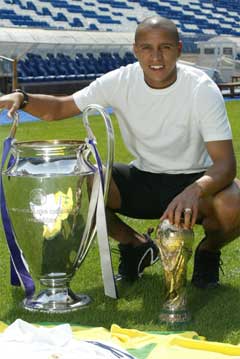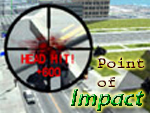
 Personal Details
Personal Details
Full name: Roberto Carlos da Silva
Date of Birth: April 10, 1973
Birthplace: Garca, Brazil
Height: 168 cm
Weight: 69 kg
Current Club: Real Madird
Previous Clubs: União São João (Brazil), Palmeiras (Brazil), Internazionale (Italy)
Technical Details
Kick speed: 170 km/h
Hand throwing side shots: 36 m
Composição Corporal: 7% fat (average is 15%)
Thigh's circumference: 58.5 cm
Impulsão Vertical: 66 cm de altura
Speed: 0 to 100 meters: 10.6 seconds
Maximal speed: 34 km/h
"God gave me a gift for kicking fouls. But training is very important too. One who intends learning how to kick fouls must train hardly." -Roberto Carlos
When It Started
Roberto Carlos was born in Garça, an inland city of State São Paulo, at Farm São José, where there are still coffee plantations. His parents, Mr. Oscar and Mrs. Vera Lúcia, a humble but solid family of farm hands, by noticing the son's skills (Roberto Carlos) encouraged him to develop a career as a football player. His father (Mr. Oscar) was a great all around well-known and respected amateur athlete.
The admiration for his father was the big incentive, which encouraged Roberto Carlos to follow football trail. Seeking for a better future for the children, the parents moved to Cordeirópolis, also in State São Paulo. The State Public School Colonel José Levy was Roberto Carlos' education "cradle".
Verônica Mario Mascarin, his teacher, says: "Roberto Carlos was a good boy who kept good relationship with everyone, he has always been a leader". Marta Iria M. Bertanha, another teacher, states: "Roberto Carlos always said, my father is an athlete and I wish to be a hero like him".
Often he showed medals and trophies that his father conquered in football games. But at physical education it was he organizing the teams and leading the whole group. An excellent scholar, disciplined and getting good concepts.
"I am retired but I am proud of seeing him at football fields all around the world and my heart bits strong at this scene, success for you, my boy Roberto Carlos", says the teacher.
As all children of poor origins he started early at 12, working at a textile industry called Torsão Cardeiro thinking always about football. One day he told his father of his dream of becoming a great football player and also of the great obstacles as he had no time for training. His father, Mr. Oscar, even considering their difficult situation told him: "Let the job go and follow your dream". "This became the happiest day of Roberto Carlos' life", says the father touched and grateful for the lighted decision.
Where It Started
 The stages where the great star has been built up, Sugar plant Engenho Velho Stadium, Araras, one of São Paulo's most beautiful. The stages where the great star has been built up, Sugar plant Engenho Velho Stadium, Araras, one of São Paulo's most beautiful.
"First comes God, then the family, the work and recreation which is football, my great passion". Those have been father Oscar's lessons. The uncultivated area behind his place was the field where Roberto started his first kicks.
In 1985, playing for his father's team Atlético Juventus, his first trophy, already distinguishing as a left striker. Playing for Flamenguinho in 1986, Coach João Carlos Campos, known as Pacheco, concluded that the correct place was as left defender and
there he placed Roberto Carlos. What a sensibility and large future vision!
The Career
Roberto Carlos began his career as a forward at Uniao Sao Joao at 16 and represented Brazil for the first time at 18 in the 1992 Olympic qualifying tournament. Endowed with a very powerful shot, he moved to Palmeiras. As a full-back he has won more plaudits for his attacking play than his defending yet he was unhappy for four months at Inter Milan where the club's English coach Roy Hodgson moved him up into midfield. Roberto Carlos, overlooked for the 1994 World Cup finals where Branco and Leonardo were preferred, likes his position. "I like to go up along the touchline but I also like defending. I'm learning to defend more," he says. Paris St Germain could have had him for about $3 million in 1995. Instead he went to Inter for some $7 million. After one season he moved on to Real, joining another of the Spanish club's Italian signings, coach Fabio Capello. Quick in turning defence into attack down the left, the Brazilian international is a fine corner taker and has a devastating shot at set pieces. A free kick specialist remembered for his spectacular goal against France in a summer international, Roberto Carlos says he works at his free-kicks every day and the only secret is concentration. "I always practise, every day. I prefer to kick with the outside of my foot. There's no secret, it's much more (a question of) concentration."
| 1988 |
Starts his career at the lower teams of União São João of Araras, participating up to 26 games. |
| 1989 |
Promoted to the juvenile series of União São João, plays his first official championship organized by São Paulo's Football Federation (FPF). Plays 28 games and gets the vice-championship. |
| 1990 |
Climbs up to junior series and gets also the FPF's vice-championship, after playing 35 games. |
| 1991 |
Still as junior, starts playing in the main professional team. Participates in 41 games of São Paulo's Championship. During this same year gets the first call for Brazilian National Team and plays the Pre-Olympics in Paraguay. |
| 1992 |
Becomes a professional, takes definitively the left defender position at União São João and is transferred to Palmeiras. |
| 1993 |
Gets the first call for the main Brazilian National Team. |
| 1995 |
Is transferred from Palmeiras to Internazionale. |
| 1996 |
Is transferred from Internazionale to Real Madrid of Spain. |
| 1998 |
Vice campeão no mundial na França. |
| 2002 |
Campeão Mundial no Mundial Korea Japão. |
Titles

| 1991 |
Juniors World Vice-Champion (Brazilian Team) |
| 1991 |
Pre-Olympics Champion (Brazilian Team) |
| 1993 |
São Paulo's Champion (Palmeiras) |
| 1993 |
Champion of Rio-São Paulo tournament (Palmeiras) |
| 1993 |
Brazilian Champion (Palmeiras) |
| 1994 |
Twice São Paulo's Champion (Palmeiras) |
| 1994 |
Twice Brazilian Champion (Palmeiras) |
| 1995 |
São Paulo's Vice-Champion (Palmeiras) |
| 1996 |
Spanish League Champion (Real Madrid) |
| 1996 |
Umbro Cup Champion, tournament played in England (Brazilian National Team) |
| 1996 |
Pre-Olympics Championship (Brazilian National Team) |
| 1996 |
Vice-Champion Olympic Games Atlanta (Brazilian National Team) |
| 1997 |
Spanish League Champion (Real Madrid - season 96-97) |
| 1997 |
America's Cup Champion (Brazilian National Team) |
| 1997 |
Nations Cup Champion in Saudi Arabia |
| 1998 |
Europe's Champions Cup (Real Madrid) |
| 1998 |
World Vice-champion in France (Brazilian National Team) |
| 1998 |
Intercontinental Cup Champion (Real Madrid) |
| 1999 |
Two times Champion of European's Champions Cup (Real Madrid) |
| 2000 |
Champion of Spanish League (Real Madrid - season 00-01) |
| 2001 |
Three times Champion of European's Champions Cup (Real Madrid) |
| 2002 |
UEFA's Supercup Champion |
| 2002 |
World Cup Champion, Japan - Korea (Brazilian National Team) |
| 2002 |
Intercontinental Cup Champion (Real Madrid 2 x 0 Olimpia) |
| 2003 |
Champion of Spanish League (Real Madrid - season 02-03) |
THE Free Kick
 Many fans will remember the free kick taken by Roberto Carlos against France in 1997. The ball was placed about 30 m from the goal and slightly to the right. Carlos hit the ball so far to the right that it initially cleared the wall of defenders by at least a metre and made a ball-boy, who stood metres from the goal, duck his head. Then, almost magically (although there's a scientific aspect to it), the ball curved to the left and entered the right-hand corner of the goal, which left Barthez helplessly standing - to the amazement of the players and media alike. Many fans will remember the free kick taken by Roberto Carlos against France in 1997. The ball was placed about 30 m from the goal and slightly to the right. Carlos hit the ball so far to the right that it initially cleared the wall of defenders by at least a metre and made a ball-boy, who stood metres from the goal, duck his head. Then, almost magically (although there's a scientific aspect to it), the ball curved to the left and entered the right-hand corner of the goal, which left Barthez helplessly standing - to the amazement of the players and media alike.
Roberto Carlos in TCM 2003

Characteristics
Music style: "Pagode" and Brazilian Country Music
Singer: Chitãozinho and Xororó, Zezé di Camargo and Luciano, Bruno and Marrone
Singer: Gloria Estefan
Idol: Mr. Oscar, his father
Coringa: His wife, Alexandra
Food: Rice, beans and pasta
Movie: Smoking
Color: Black
Joy: The children, Giovanna, Roberta and Junior
Sadness: His Uncle's death
Quality: Good humor
Fault: Hard-headed
Gallery
Read more
|




